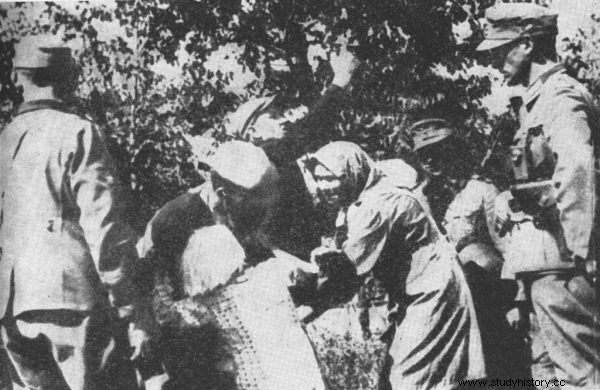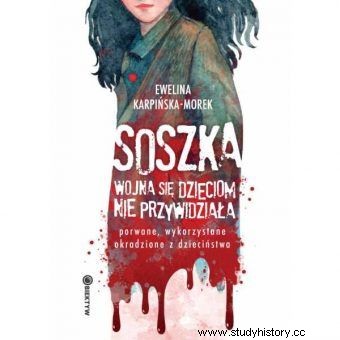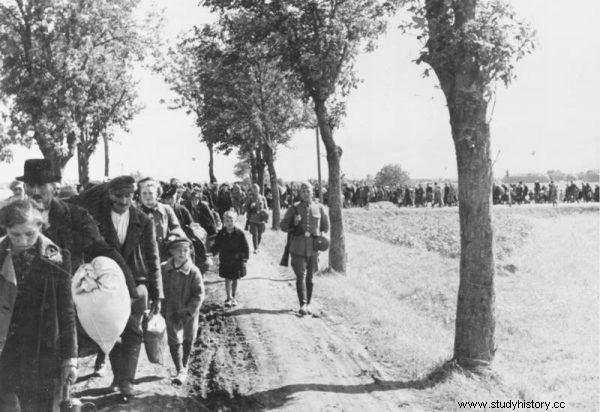The situation of children during World War II was tragic. The youngest, involuntary participants of the conflict went through such a hell that death seemed to be their salvation ...
During World War II, Łódź became a hellish city - and hellishly well organized. There was a ghetto here, a concentration camp for Polish youth, resettlement camps, as well as a branch of the Main Office of Race and SS Settlement.
It constituted an extremely important element of the Generalplan Ost - General Plan for the East, under which the Third Reich wanted to provide "living space" for the Aryan people. It seemed to be within easy reach, thanks to the extremely dynamic network of institutions and - above all - thanks to the extremely committed, ambitious officials and officers.
Łódź ghetto
A "special" zone for the town's Jewish inhabitants was established in February 1940. Two months later, the district was completely isolated. All this was a prelude to September 5, 1942, when the Allgemeine Gehsperre was introduced here - a total ban on leaving homes. The unfolding drama was preceded by a speech by the Head of the Jewish Eldership, Mordechaj Chaim Rumkowski, on September 4:
A grim gust hit the ghetto. They are asking us to give up the best we have - our children and the elderly. (…) At my age, I have to spread my hands and plead:Brothers and sisters! Give them back to me! Fathers and mothers - give me your children!

Robbery of Polish children during the displacement operation in the Zamość region
In fact, the aim of the action was cleansing the ghetto of the youngest and the oldest. From the perspective of the Third Reich, they were completely useless. Rumkowski tried to mitigate the tragedy by negotiating with Germany. Instead of the requested 24,000 people, he managed to "go down" to 20,000. However, he had to agree to the release of all children under the age of 10, elderly and people unable to work.
It is hard to imagine that the ghetto inhabitants would take the result of the negotiations at face value. Rumkowski asked them:
Help me carry out this action. (...) The broken Jew is standing in front of you. Do not envy me. This is the hardest of all orders I have ever had to give. I hold out my broken, trembling hands to you and beg you:give these hands victims! This is the only way we can prevent future suffering and the group of 100,000. Jews can be preserved.
It is estimated that during the entire period of the ghetto's existence, it witnessed the tragedies of about 200,000 people in total. What was wrong with them?
Resettlement actions
On May 15, 1941, the Germans came to Zosia's house. At three in the morning, the family, in their sleep, heard a pounding on the door. At the behest of her mother, Zosia hid under the bed. An armed German soldier, an interpreter and a village administrator burst into the apartment and read her brother's name from the list. Just a brother.
He begged that he would not have to go alone, so that Zosia could go with him. It took a while before they found her. The girl, paralyzed with fear, did not respond to the exhortations of the German officer. Finally, the man jumped on the bed and, jumping furiously on it, tore it up, then yanked the baby from under it and severely beat it.
Zosia and her brother - like many other Polish children - ended up in a camp in Łódź, where their fate was to be decided. The resettlement camp at Łąkowa Street was a gathering point, registration and distribution point for Polish women and toddlers brought here from Pomerania, Kujawy, the vicinity of Poznań and Łódź. As stated in the ordinance of April 1, 1940:
Poles displaced from the Warta Region in connection with the action of settling Germans from Volhynia will be transported from their current place of residence to Łódź, there they will be deloused in the municipal bathing establishment, and then led to the camp under my command And at ul. Łąkowa.

The text is based on the book by Ewelina Karpińska-Morek “Soszka. Children did not dream of war ”, which has just been published by Wydawnictwo M.
On the spot, the small inmates were locked in rooms originally lined with straw, but when Zosia was brought here, the straw was only a memory. As we read in Ewelina Karpińska-Morek's book “Soszka. The children did not dream of war ":
They cannot sleep at night. There is little space. Those present in the hall try to take turns to sleep. The walls, the floor - they all smell musty, dirty, and sweat. People torn from their beds are now lying on the flea-stained, almost bare floor. Their black bread and coffee keep them alive. They get half a loaf. Sometimes there is a soup - made of turnips or fodder beet. Fasting, barren.
Between 10 and 15 children died daily in the resettlement camps. Some of the others, however, were selected and had a red bow attached to their clothes - a "ticket to heaven". According to the ideologues of the Third Reich, this meant a great opportunity for the children gathered in the camp. Thanks to this, they could find their way to a German family and work there in exchange for their lives. Previously, however, they landed in the camp on Sporna Street, where they were thoroughly washed, and then measured and compared with the requirements of the "Aryan race".
Learn more:Nazi arithmetic. How many percent of Jewish blood was enough to be considered a Jew in the Third Reich?
"Unwanted natural increase"
In its propaganda, the Third Reich built the image of a state that was growing in strength. However, in order to become an economic power and show the nation the tangible benefits of waging war, cheap, preferably free, labor had to be provided. For this purpose, round-ups were carried out in Poland. A network of Arbeitsamts was also created - offices that supervised the forced labor imposed on Poles.
With time, however, more and more workers were needed. The war plans related to the USSR, the need to increase production in the Reich and numerous displacement programs meant that younger and younger children began to be sent to work. Along with the secret circular of June 12, 1942, it was assumed that the law protecting children no longer had to be respected in relation to little Poles.

The expulsion of Poles from the Warta Region
The children were used for harvesting, river regulation, peat extraction, potato sorting, road construction, and even gasoline production. Soon the little ones were divided into two categories - those suitable for Germanization and those referred to as "undesirable birth rate". Assigned to the second category - as hyperactive or unfit for upbringing - they had to earn their own living.
This operation was quickly codenamed "Operation Hay" - Heuaktion and lasted from 1941 to October 1944. The children were forced to work superhumanly, often requiring the performance of adults. In 1944, as part of Heuaktion, between 40,000 and 50,000 Polish children were deported to forced labor.
The war did not spare anyone. Even the little ones. There was no substitute for the taken away childhood. And yet these little ones lost much more than "just" their childhood:siblings, parents, dignity, strength, hope and - too often - also their young lives.
Source:
The text is based on the book by Ewelina Karpińska-Morek “Soszka. Children did not dream of war ", which has just been released by the M. Publishing House. It is a gloomy testimony to the cruelty of those times.
